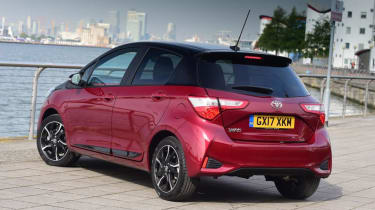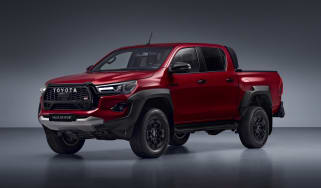Used Toyota Yaris (Mk3, 2011-2020) review - How practical is it?
With its Tardis-like interior, the Toyota Yaris serves up plenty of space for passengers and luggage alike
Every version of the Yaris comes with a five-door bodystyle. And, interior space is an area where the little Toyota excels, as the little supermini provides enough accommodation to rival larger models in the compact family class, such as the Ford Focus.
Even with the hybrid, Toyota hasn't compromised on space, thanks to clever packaging of the petrol/electric drivetrain, which means boot capacity is unaffected. The battery pack does encroach into the rear footwell, however, leaving an awkwardly shaped bulge for back seat occupants to place their feet around.
Still, the driving position is pretty good in all versions of the Yaris – although some will find the seats set too high in the GR Sport – particularly if you specify seat height adjustment to go with the fully adjustable steering column that comes as standard. The upright driving position also ensures great visibility.
The rear provides a decent amount of room for three people, and no matter where you’re sitting in the car, there are plenty of storage spaces and cubbyholes for odds and ends.
Dimensions and cabin design
One of the secrets of the Yaris’s success is a high cabin which – combined with that relatively upright seating – gives a great sense of space inside. At 1,510mm tall, the Toyota is higher than the 1,495mm Ford Fiesta and 1,462mm Volkswagen Polo.
It’s also shorter than both rivals, though; the Yaris measures 3,945mm in length, compared to the Ford’s 3,969mm and the VW’s 3,970mm.
As you would expect, the five-door model allows for easy access to the rear seats, which will be especially relevant if you intend to use the Isofix child seat mountings. There's plenty of rear leg and headroom, and three adults can fit in the back – although taller passengers probably wouldn’t want to spend too long sitting there.
Boot space
Toyota claims the boot in the latest Yaris is 25 per cent bigger than the previous-generation car’s, serving up a capacity of 286 litres with the rear seats in place. That's quite spacious, and edges the Volkswagen Polo. With the rear seats folded, this increases to 768 litres. It’s just a shame the seats don’t fold completely flat, while the relatively high lip can make loading a little awkward.
Equipment and technology
A 2017 facelift for the Yaris reportedly introduced 900 new parts to the car, with a new front and rear-end design giving the model a contemporary Toyota family feel. The quality and feel was improved inside, too, with a new TFT screen instrument panel for all but the basic Active model.
The entry-level Yaris Active is pretty basic, with 15-inch steel wheels, a six-speaker CD system and Bluetooth, but you do also get a pre-collision warning system, automatic air-con and automatic wipers thrown in. The Icon is next up with 15-inch alloys and a 7-inch touchscreen with a reversing camera and a push-button start, while the Icon Tech adds navigation and parking sensors.
The range-topping Excel adds partial leather and Alcantara upholstery, automatic climate control and auto headlamps. Bi-tone models feature LED lights, a two-colour paint-job and rear power windows.
In 2019, Toyota added two interesting new options to the line-up. The Y20 model celebrated 20 years of the Yaris with a number of visual additions such as two-tone paint jobs reminiscent of the Mk1 model's colour palette, 16-inch alloy wheels and a few Y20 bespoke elements in the cabin.
Meanwhile, the GR Sport added a bit of hot-hatch flavour to the regular line-up. Highlights included a bodykit inspired by the range-topping GRMN model plus some suspension and steering revisions; it was offered with the Yaris' hybrid powertrain.
The limited-edition GRMN hot hatch was a halo for the Yaris badge with a unique look and suspension set-up. It also stood out from other Yaris models thanks to its engine: a supercharged 1.8-litre four-cylinder unit that is all-but identical to the engine found beneath the rear bodywork of the Lotus Elise.
Dominating the dashboard of the Yaris is the seven-inch touchscreen that’s central to the Toyota Touch 2 multimedia system. The navigation system is relatively simple to operate and shows 3D images of key features on your route, but the screen looks old fashioned now and isn't very responsive.
In addition, owners can access features such as Google Street View and social media apps through the Touch 2 display, while the options list includes features like a mobile hotspot.
Safety
The Mk3, pre-facelift Yaris was awarded a five-star Euro NCAP crash test rating. You get seven airbags and tyre pressure monitors as standard and all cars get a pre-collision system, lane departure warning and auto high beams.




